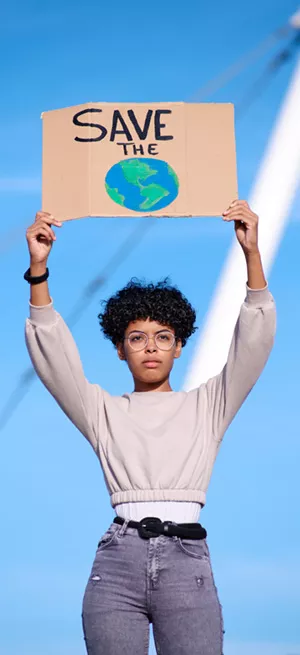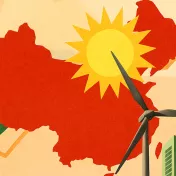The conflict between the US and China over leadership in the coming world order is becoming more intense - and forcing the EU to clarify its own relationship with China. Co-operation on climate policy can play a key strategic role in this process. It is therefore high on the agenda of the German EU Council Presidency in the second half of this year.
On Monday the EU leaders - Commission President Ursula von der Leyen and Council President Charles Michel - will meet with Chinese Prime Minister Li Keqiang for the annual EU-China Summit, this time via video conference. The special summit with Chinese President Xi Jinping and all 27 EU leaders, originally planned for September, has been postponed due to the COVID-19 pandemic, but is expected to be held later this year, if possible.
Instead of being drawn into the bipolar logic of a new Cold War, Europe should develop an independent relationship with China. In a strategy paper last year, the EU stated that China is simultaneously a co-operation partner, a negotiating partner, an economic competitor and a systemic rival. China and the EU have partly conflicting values and interests - for example in the field of human rights or in foreign trade and foreign investment. The EU should also be unequivocally committed to the protection of human rights. But China and the EU also have common interests - for example in tackling global challenges such as climate change. And both sides agree that they want to rely on multilateral, rule-based solutions.
It is obvious that the global climate crisis cannot be contained without China - the world's largest emitter of greenhouse gases. An agreement on more ambition in climate protection is in the strategic interest of both sides. China has been massively affected by glacier melt in the Himalayas and sea-level rise and can gain much of the desired global recognition through a more ambitious climate policy. The EU can act as a geopolitical actor that can reach agreement even with difficult partners and lend international appeal to its vision of the European Green Deal. Above all, however, both sides should have an interest in climate cooperation becoming an "anchor of co-operation" in increasingly conflict-laden relations.
Anchor of co-operation means that both sides have an overriding interest in co-operation in this area, which will continue even if there are growing conflicts in other policy areas. The situation was similar during the period of the East-West conflict with gas supplies from the Soviet Union to Western Europe. They were in the interests of both sides and therefore not called into question, even when crises came to a head.
The EU needs clearly defined objectives for climate co-operation with China. It is not enough to have a declaration that merely reaffirms the Paris Climate Accord in elegant terms. A climate co-operation agenda with China must include four issues:
Firstly, economic recovery after the corona crisis should be organised to help contain the climate crisis. In addition to agreeing on this principle, both sides need to be specific about the instruments that can steer future investments into climate-compatible paths. For example, both sides could agree to make the recommendations of the Task Force on Climate-Related Financial Disclosures (TCFD) on the disclosure of climate risks by companies and investors binding. Both regions have also developed catalogues of criteria for sustainable investments in recent years, such as the so-called Sustainable Finance Taxonomy in the EU. Both sides could agree to harmonise these definitions and align public investments accordingly. Such cooperation on sustainable finance would set a standard to which investors around the world would have to orient themselves, including, for example, in the USA. Even if Trump were not to be voted out of office.
Secondly, it was agreed at the Paris Climate Conference that by the end of 2020 all parties to the agreement would review and increase their national climate protection contributions in order to meet the global climate targets. This commitment applies even though the next UN Climate Change Conference has been postponed to 2021. Both China and the EU see themselves as defenders of multilateralism and the Paris Agreement. They should therefore submit their improved climate targets by the end of the year. If they agree to do so, this would increase the scope for more ambitious targets on both sides and send a global signal.
Third, both sides can also promote climate change transformation in third countries, for example by supporting countries and regions where both the EU and China are major investors, such as the Western Balkans or Africa. The EU's own principles ("European Green Deal" in the EU, "Ecological Civilization" in China) should also apply to investments in third countries - both sides could agree on corresponding criteria.
Fourthly, there is the link between the climate and biodiversity crises. China is the host of the upcoming UN biodiversity conference and is therefore in the global spotlight. If China and the EU, as the world's largest demand markets for palm oil, soya and beef, agreed to demand only those products that are proven not to accelerate deforestation, this would not only be good for the climate, it would also protect some of the biodiversity hotspots on this planet.
The EU-China video conference on Monday can only be the beginning. It should signal: Co-operation continues, climate protection will play a central role and we are now preparing the major climate policy steps in the second half of the year. The heads of state and government are needed to ensure that the breakthrough to ambitious co-operation is achieved in a time of tension. It is in our mutual interest to make joint climate policy a priority.
This piece was first published in German in Tagesspiegel Background Energie & Klima on June 19th, 2020.





